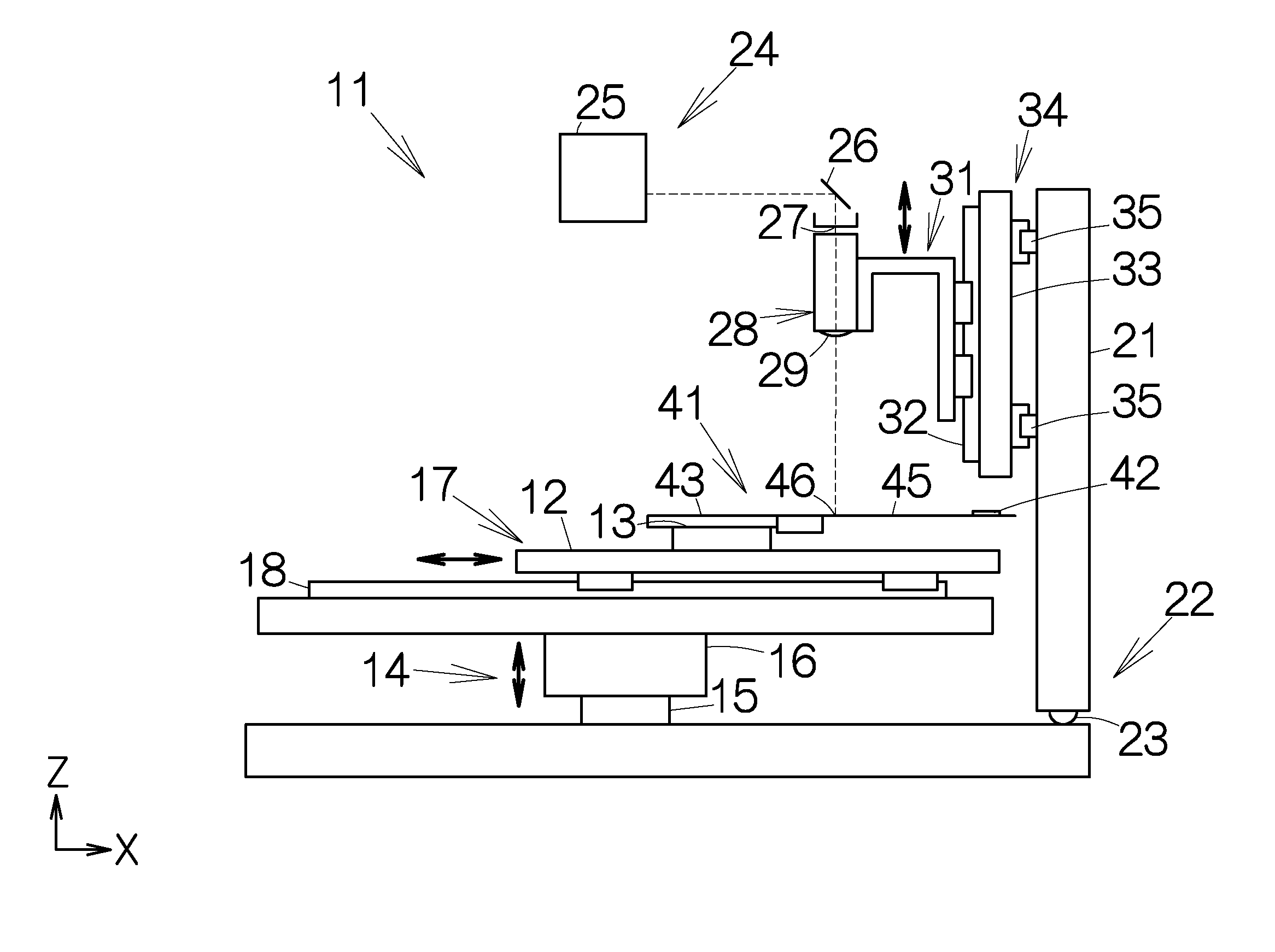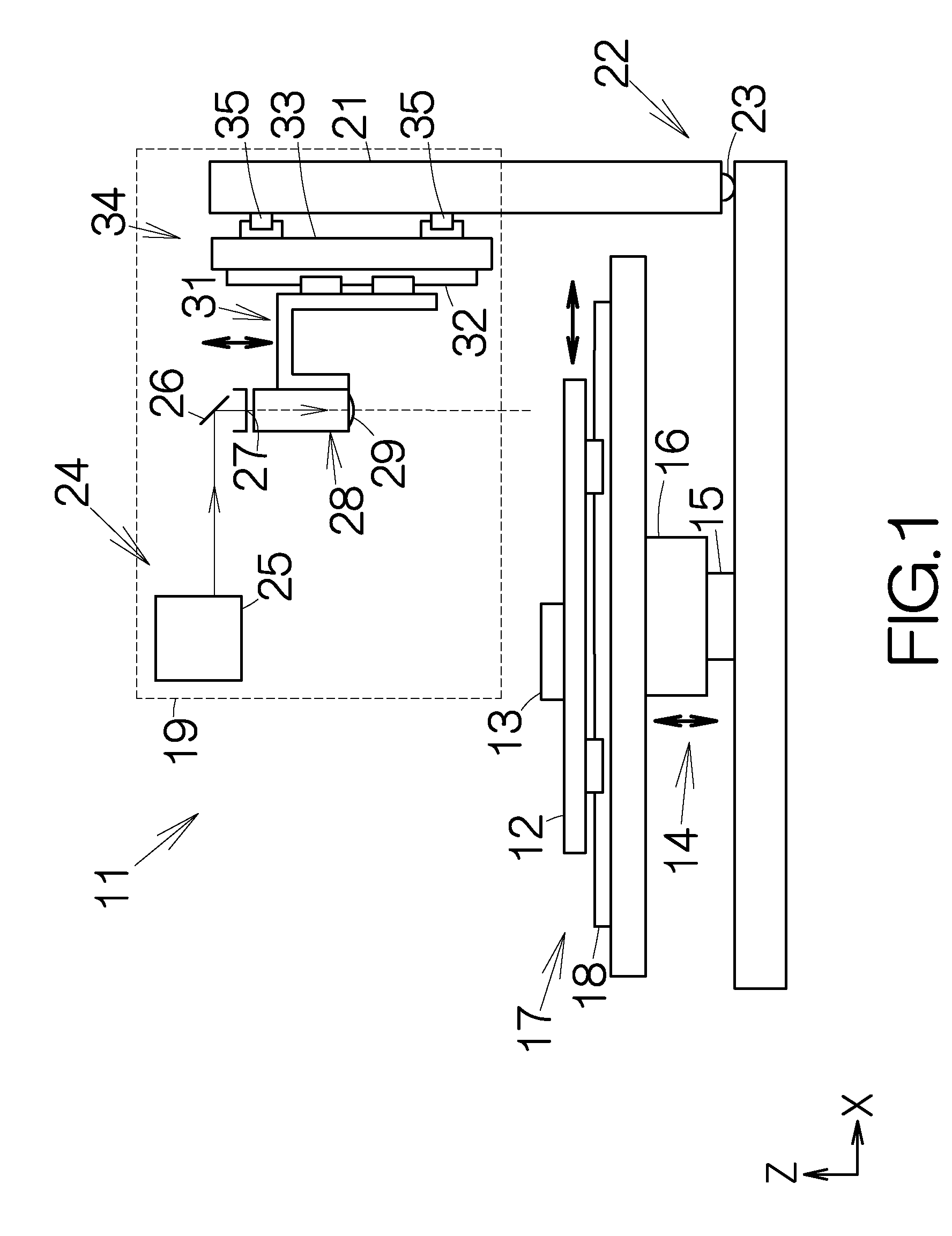Processing apparatus and method of processing and method of making leaf spring
a processing apparatus and leaf spring technology, applied in the direction of lasers, head supports, manufacturing tools, etc., can solve the problem of not being able to stabilize the driving voltage immediately after, and achieve the effect of high accuracy
- Summary
- Abstract
- Description
- Claims
- Application Information
AI Technical Summary
Benefits of technology
Problems solved by technology
Method used
Image
Examples
first embodiment
[0036]An optical system 28 is connected to the output end 27 of the laser source 24. The optical system 28 includes a collective lens 29. The optical axis of the collective lens 29 is aligned with the optical axis of the aforementioned output end 27. The collective lens 29 is designed to focus the laser beam. The laser beam is emitted in the direction of gravity through the collective lens 29. The position of the collective lens 29 can be changed in the z-axis direction. The collective lens 29 is attached to a z-axis positioning mechanism 31. The z-axis positioning mechanism 31 drives the collective lens 29 in the z-axis direction. The z-axis positioning mechanism 31 includes a guide rail 32. The collective lens 29 is mounted on the guide rail 32. The guide rail 32 extends on a support member 33 in the vertical direction or in the z-axis direction. The guide rail 32 is designed to guide the movement of the collective lens 29 in the z-axis direction. A ball screw mechanism or a line...
second embodiment
[0067]FIG. 11 schematically illustrates an optical system 28a according to a An optical filter 53 is located in a space between the output end 27 and the collective lens 29 in the optical system 28a, for example. The optical filter 53 is designed to stepwise or continuously change an optical density for a laser beam within a certain range. Specifically, the optical filter 53 serves to change the light intensity of the laser beam emitted through the collective lens 29. A change in the light intensity of the laser beam induces a change in the energy density per unit time. As a result, the energy per minute unit area is likewise kept constant irrespective of a change in the relative velocity between the collective lens 29 and the object in the same manner as described above. Specifically, the optical filter 53 serves to decrease the amount of transmission of the laser beam when the collective lens 29 accelerates relative to the object in the y-axis direction. The optical filter 53 lik...
third embodiment
[0069]FIG. 13 schematically illustrates an optical system 28b according to a A diaphragm 58 is located in a space between the output end 27 and the collective lens 29 in the optical system 28b, for example. The diaphragm 58 is designed to stepwise or continuously change an aperture area within a certain range. Specifically, the diaphragm 58 serves to change the light intensity of the laser beam. The energy per minute unit area is likewise kept constant irrespective of a change in the relative velocity between the collective lens 29 and the object in the same manner as described above. The diaphragm 58 may utilize diaphragm blades so as to adjust the amount of transmission of the laser beam, for example. The diaphragm 58 may utilize any other structures different from the aforementioned one. In this embodiment, the diaphragm 58 is immobilized to the support column 21 at a position on the optical axis of the output end 27. Alternatively, the diaphragm 58 may move along with the colle...
PUM
| Property | Measurement | Unit |
|---|---|---|
| central angle | aaaaa | aaaaa |
| energy | aaaaa | aaaaa |
| diameter | aaaaa | aaaaa |
Abstract
Description
Claims
Application Information
 Login to View More
Login to View More - R&D
- Intellectual Property
- Life Sciences
- Materials
- Tech Scout
- Unparalleled Data Quality
- Higher Quality Content
- 60% Fewer Hallucinations
Browse by: Latest US Patents, China's latest patents, Technical Efficacy Thesaurus, Application Domain, Technology Topic, Popular Technical Reports.
© 2025 PatSnap. All rights reserved.Legal|Privacy policy|Modern Slavery Act Transparency Statement|Sitemap|About US| Contact US: help@patsnap.com



